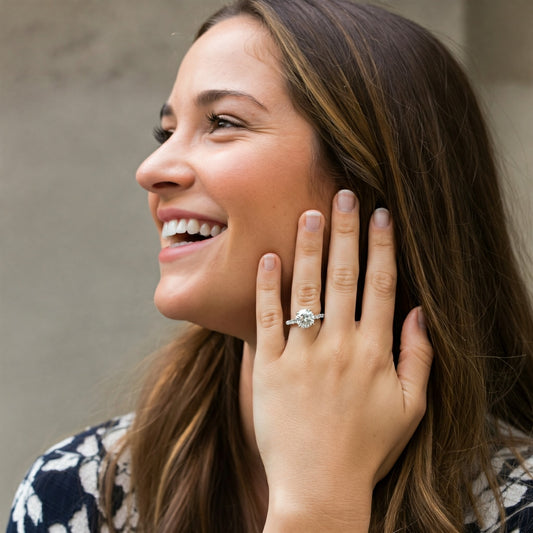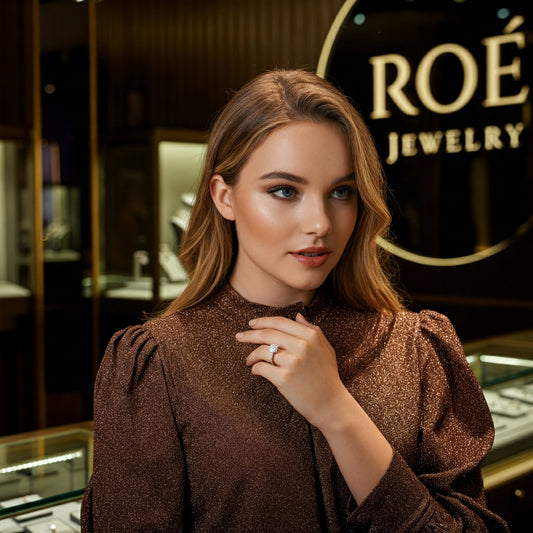The allure of diamonds transcends time, captivating us with their brilliance and beauty. But beyond the 4Cs - Cut, Clarity, Color, and Carat weight - the shape of a diamond plays a significant role in its overall appeal and how it reflects your personal style.
In this guide, we'll explore the fascinating world of diamond shapes, uncovering their unique characteristics and helping you make an informed decision when choosing the perfect cut for your engagement ring or other cherished jewelry piece. If you're new to diamonds or need a refresher on the 4Cs, be sure to check out our comprehensive guide on buying diamonds in Kansas City.
Understanding Diamond Cut: Beyond the Basics
While the 4Cs are essential for evaluating a diamond's quality, it's the cut that truly unlocks its brilliance and fire.
Diamond Cut vs. Shape
It's important to distinguish between a diamond's cut and its shape. The cut refers to the precision and symmetry with which the diamond's facets are arranged, influencing how light interacts with the stone. The shape, on the other hand, is simply the outline of the diamond, such as round, oval, or pear.
Anatomy of a Diamond
Understanding a diamond's anatomy is key to appreciating how its cut affects light performance. The main parts of a diamond are:
- Table: The flat top facet
- Crown: The upper portion of the diamond
- Girdle: The widest part of the diamond, separating the crown from the pavilion
- Pavilion: The lower portion of the diamond
- Culet: The tiny point at the bottom of the pavilion (may be absent in some cuts)
Light Performance: The Dance of Brilliance, Fire, and Scintillation
The way a diamond is cut determines how light enters and exits the stone, creating the mesmerizing effects we associate with diamonds:
- Brilliance: The white light reflected from the diamond's surface and interior.
- Fire: The flashes of colored light dispersed by the diamond.
- Scintillation: The sparkle and pattern of light and dark areas created as the diamond or the observer moves.
A well-cut diamond maximizes these effects, creating a dazzling display of light and color.
Cut Grades: The GIA Standard
The Gemological Institute of America (GIA) has developed a comprehensive diamond cut grading system, ranging from Excellent to Poor. This system evaluates a diamond's proportions, symmetry, and polish, providing a reliable indicator of its light performance and overall beauty. You can learn more about GIA's cut grading system on their website: GIA 4Cs of Diamond Quality.
Popular Diamond Shapes and Their Characteristics
Now, let's explore the most popular diamond shapes and their unique characteristics:

Round Brilliant
The most popular and classic diamond shape, known for its maximum brilliance and fire. It's a versatile choice that complements any setting and style.

Princess Cut
A square or rectangular shape with sharp corners, offering a modern and geometric aesthetic. It's a popular choice for those seeking a contemporary look.

Cushion Cut
A square or rectangular shape with rounded corners, evoking a romantic and vintage-inspired feel. It's known for its soft, pillow-like appearance and exceptional fire.

Oval Cut
An elongated shape that creates the illusion of longer, slender fingers. It offers a beautiful balance of brilliance and fire.

Pear Shape
A unique teardrop shape with a pointed tip and rounded bottom, adding a touch of individuality and elegance.

Marquise Cut
An elongated shape with pointed ends, maximizing carat weight appearance and creating a dramatic, glamorous look.

Emerald Cut
A rectangular shape with step-cut facets, showcasing a diamond's clarity and color. It offers a sophisticated and understated elegance.

Asscher Cut
A square shape with step-cut facets, similar to the emerald cut but with a more vintage feel. It's a unique and geometric option.

Radiant Cut
A rectangular or square shape with brilliant-cut facets, combining the elegance of an emerald cut with the sparkle of a round brilliant. It's a versatile and modern choice.

Heart Shape
A romantic and symbolic shape, representing love and affection. It's a unique and feminine option.
Choosing the Right Shape for Your Style and Preferences
When selecting a diamond shape, consider the following factors:
- Personal Style: Do you or your partner prefer classic and timeless designs or more unique and modern looks?
- Finger Shape: Certain diamond shapes can flatter different finger shapes. For example, elongated shapes like oval or marquise can make fingers appear longer and slender.
- Setting Preferences: Consider the type of setting you envision for the ring. Some settings complement certain diamond shapes better than others.
Beyond Shape: Other Factors to Consider
While shape is a crucial factor, don't forget the other aspects that contribute to a diamond's beauty and value:
- The 4Cs: Remember to consider the cut, clarity, color, and carat weight of the diamond when making your final decision. You can refresh your knowledge on the 4Cs in our previous blog post: Sparkle & Shine: Your Guide to Buying Diamonds in Kansas City.
- Certification: Choose a diamond with a reputable certification, such as GIA or AGS, to ensure its quality and authenticity.
- Setting and Metal: Select a setting and metal that complement the diamond shape and your overall style. Explore our collection of engagement rings for inspiration.
- Budget: Set a realistic budget and explore financing options if needed. We offer flexible payment plans to help you find the perfect ring without breaking the bank. Learn more about our financing and leasing options.
Conclusion
Choosing the perfect engagement ring is an exciting journey. Remember, the most important thing is that the ring reflects your love and commitment. At ROE Jewelry, we're here to guide you through the process and help you find the ring that will make your partner's heart skip a beat.
Ready to start your search? Explore our stunning collection of engagement rings or schedule a complimentary consultation with our jewelry experts. Let's create a ring as unique and beautiful as your love story!




